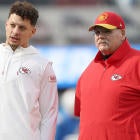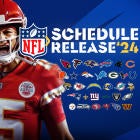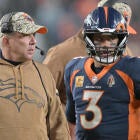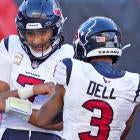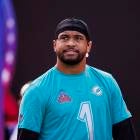Eli Manning led the NFL with a career-high 27 interceptions in 2013. There was speculation that a quarterback could be taken early in the 2015 NFL Draft if newly hired offensive coordinator Ben McAdoo (now head coach) didn't resurrect the Super Bowl XLVI MVP's career.
Manning became more comfortable in McAdoo's West Coast offense as the 2014 season progressed. His strong finish led to a four-year, $84 million contract extension with a then-NFL record $65 million in overall contract guarantees right before the start of last season.
A different set of players face a crossroads or have something to prove every year for a variety of reasons. The most common reasons are related to age, contract or salary cap concerns, injury, poor performance or off the field issues. After examining AFC players facing a pivotal year in 2016, here are players to watch on NFC teams that fall into these categories.
Arizona Cardinals: Michael Floyd
Floyd rebounded from a slow start in 2015 to have three 100-yard receiving games during December. He finished the season with 52 catches for 849 yards and six touchdowns.

An extension for Floyd, who is making $7.32 million in the option year of his rookie contract, seems unlikely, considering the Cardinals have higher signing priorities (defensive back Tyrann Mathieu and defensive end Calais Campbell). Floyd hitting the open market next March could depend on whether 13-year veteran Larry Fitzgerald, who is also in contract year, retires after the season.
Atlanta Falcons: Matt Ryan
Ryan didn't make a smooth transition to offensive coordinator Kyle Shanahan's system. He admitted late in the 2015 season to being overwhelmed at times by Shanahan's playbook. If Ryan's growing pains with the new offense continue through this season, it might be time for the Falcons to start looking for a quarterback who is a better fit.
Carolina Panthers: Bene' Benwikere
Carolina rescinding Josh Norman's $13.952 million franchise tag was a curious decision given that salary cap room wasn't a problem. Benwikere, who has started 10 of 23 career games in two NFL seasons, becomes a leader in the secondary with Norman's departure and Charles Tillman's retirement. The Panthers used three consecutive draft picks on cornerbacks in the second, third and fifth rounds to address the glaring need by selecting James Bradberry, Daryl Worley and Zack Sanchez, respectively.
Chicago Bears: Jeremy Langford
Langford has big shoes to fill following in the footsteps of Matt Forte, the consummate dual-threat running back. The Bears weren't interested in re-signing a 30-year-old with over 2,000 career carries. Langford rushed for 537 yards on 148 rushes (3.6 yards per carry) and caught 22 passes for 279 yards last season as a rookie.
Dallas Cowboys: Tony Romo
The Cowboys will go as far as Tony Romo takes them. A broken collarbone that limited Romo to four games in 2015 derailed Dallas' chances to repeat as NFC East champions. The Cowboys were 1-11 without him.
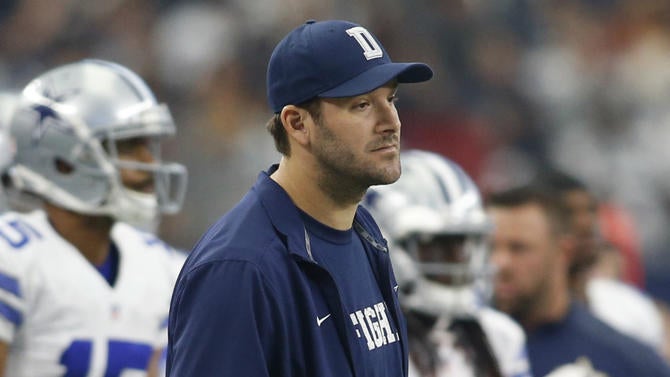
Despite this, the Cowboys stood pat with Kellen Moore as Romo's backup and didn't address quarterback until the fourth round of the draft with Dak Prescott. If health becomes an issue again for their 36-year-old signal caller, the Cowboys will likely regret that they didn't make upgrading quarterback more of an offseason priority.
Detroit Lions: Matthew Stafford
Stafford lost one of the game's most dangerous offensive weapons, six-time Pro Bowl wide receiver Calvin Johnson, to a premature retirement. If Stafford thrives without his security blanket, he will be sitting in the driver's seat in 2017 when he is entering his contract year. Allowing Stafford to play out his contract after a successful 2016 season would be risky. It will be $26.4 million (120 percent of his $22 million 2017 salary cap number) to use a non-exclusive franchise tag on Stafford in 2018.
Green Bay Packers: Eddie Lacy
Lacy had a 2015 season to forget. He appeared at times to be a good 20 pounds over his listed playing weight (234) and eventually lost playing time as the season progressed. Lacy rushed for a career-worst 758 rushing yards on a career-low 187 carries.
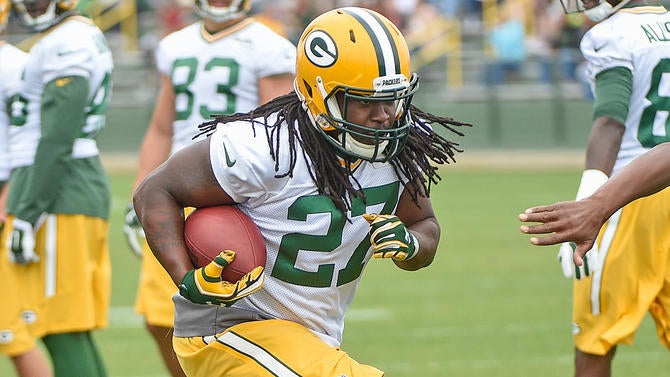
Shortly after Green Bay was eliminated by Arizona in the divisional playoffs, Lacy, who is entering the final year of a four-year rookie contract worth $3,392,412, started making a concerted effort to lose weight and get in better condition. Breaking the 1,000-yard mark for the third time in his career would go a long way towards Lacy getting the lucrative second contract that sometimes eludes running backs.
Los Angeles Rams: Tavon Austin
The Rams picked up Austin's $12.268 million fifth-year option for 2017. The option year, guaranteed for injury upon exercise, doesn't become fully guaranteed until the first day of the 2017 league year. Austin probably needs to dramatically increase his career bests of 52 receptions, 473 receiving yards and five touchdown catches from 2015 for the full guarantee to kick in next March.
Minnesota Vikings: Matt Kalil
The Vikings seem to be taking a wait-and-see approach with Kalil, whose 2016 option year salary is $11.096 million. Fellow 2012 first-round pick Harrison Smith recently received a five-year contract extension, making him the NFL's highest paid safety. Kalil showed improvement from a subpar 2014 season but didn't play at the level that got him to the Pro Bowl as an alternate after his rookie season in 2012.
New Orleans Saints: Jairus Byrd
Byrd hasn't lived up to the six-year, $52.5 million deal (worth up to $54 million with salary escalators) he signed during free agency in 2014, primarily because of injury. He has missed 15 of 32 regular season games since joining the Saints.
New Orleans moving into the second round to select safety Vonn Bell should put Byrd on notice. If Byrd isn't the ballhawk he was prior to signing his blockbuster deal this season, his days in New Orleans could be numbered. There won't be any more contract guarantees left when he has the NFL's highest cap number for a safety at $11.2 million.
Pulling the plug on Byrd after paying him $27.3 million for three seasons would create $3.2 million of cap space for the Saints unless a post-June 1 designation is used or his release occurred after June 1. $7.8 million of cap room could be gained this way, but there would be $4.6 million in dead money, a cap charge for a player no longer on the roster, in 2018.
New York Giants: Victor Cruz
Cruz hasn't played since tearing the patellar tendon in his right knee six games into the 2014 season. A calf injury cost him the 2015 season. During his absence, 2014 first-round pick Odell Beckham Jr. replaced him as quarterback Manning's go-to guy while emerging as one of the game's best young wide receivers.

Cruz, who was arguably the NFL's best slot wide receiver prior to hurting his knee, wisely took a pay cut to remain with the Giants. The 2011 All-Pro will likely need a good comeback season to stick around next year, when he's due to make $7.5 million on a $9.4 million cap number, since the Giants drafted wide receiver Sterling Shepard in this year's second round (40th overall pick). Shepard has drawn comparisons to Cruz after excelling in the slot at Oklahoma.
Philadelphia Eagles: Sam Bradford
The Eagles giving Bradford a two-year, $35 million contract (worth up to $40.5 million through salary escalators and incentives) with $26 million in guarantees prior to the start of free agency was a surprise to many. Despite the contract, Bradford should view the 2016 season as a league-wide audition.
The Eagles didn't trade up to take Carson Wentz with the second-overall pick for him to sit on the bench indefinitely. Philadelphia's cap situation will almost necessitate moving on Bradford, who has a $22.5 million 2017 cap number, before his $4 million due on the fifth day of the 2017 league year is payable early next March unless he finally lives up to being the first-overall pick of the 2010 draft.
The Eagles have a league-leading $177.91 million of 2017 salary cap commitments. $17 million of cap room would be gained by trading Bradford. It's $13 million if he is released, because $4 million of his $13 million 2017 base salary is already fully guaranteed.
San Francisco 49ers: Colin Kaepernick
The 49ers giving Kaepernick permission to seek a trade early in the offseason was evidence that the team was no longer fully invested in him. Trade talks between Kaepernick and the Denver Broncos stalled over his unwillingness to take a pay cut.
Kaepernick's inability to participate in offseason activities while recovering from knee, shoulder and thumb surgeries has given Blaine Gabbert, who took over when he was benched last season, an edge to become new head coach Chip Kelly's quarterback.

If Kaepernick can't beat out Gabbert or doesn't play well, 2016 should be his last season with the 49ers. Releasing him is most likely because of his limited trade value. The 49ers would pick up almost $14.5 million of cap room in 2017 by not having Kaepernick's $19,365,753 cap number on the books next year.
Seattle Seahawks: Jimmy Graham
Graham wasn't a great fit in Seattle's offense before tearing the patellar tendon in his right knee 11 games into the season. The three-time Pro Bowler may need to regain such status to get a third year in Seattle. The Seahawks would gain $10 million in cap room without any dead money by releasing him in 2017.
Tampa Bay Buccaneers: Alterraun Verner
Tampa Bay thought they were getting one the NFL's better playmaking cornerbacks when signing Verner to a four-year, $25.5 million contract with $14 million in guarantees as an unrestricted free agent in 2014. That hasn't been the case.
Verner was benched early last season by former head coach Lovie Smith. Reclaiming a starting job won't be an easy task because of the offseason signing of Brent Grimes and the selection of the Vernon Hargreaves with the 11th overall pick. Verner has a familiar face on the coaching staff in defensive backs coach Brett Maxie, who held the same position with the Tennessee Titans during Verner's last two seasons with the team.
Washington Redskins: Kirk Cousins
Cousins playing on his $19.953 million non-exclusive franchise tag is a no-brainer considering Washington's reported best offer of $16 million per year with $24 million in guarantees.
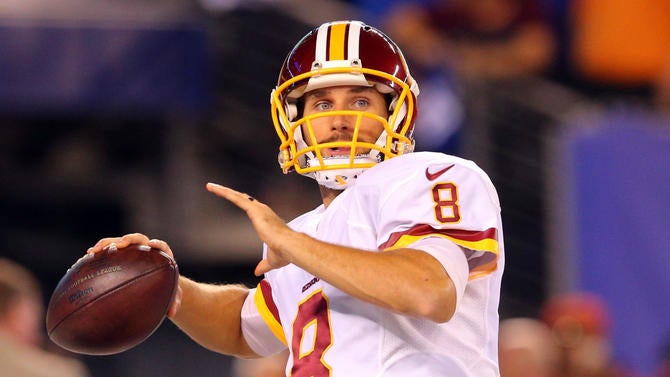
Erasing Washington's concerns about a limited track record of success during the 2016 season would force the Redskins to franchise Cousins again next year for $23,943,600 absent a long-term deal before early next March. This would put Cousins in position to command a long-term deal in the same ballpark as Indianapolis Colts quarterback Andrew Luck's recent five-year, $122.97 million extension (averages $24.594 million per year) containing $87 million in guarantees, which re-set the NFL pay scale. His downside with a slight regression or mediocre season is Brock Osweiler's four-year, $72 million deal with the Houston Texans, where $37 million is fully guaranteed, given there are more NFL teams than competent starting quarterbacks.













